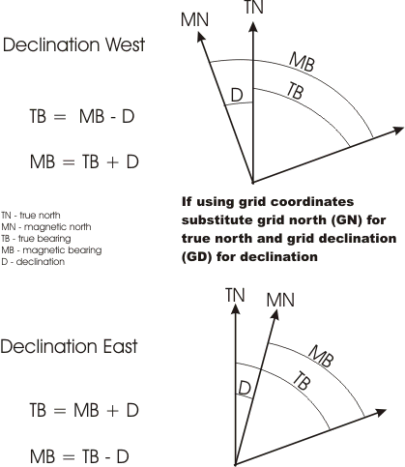Using a compass
The magnetic compass has been used for navigation for hundreds of years. At one time, it was the only reliable means of direction-finding on days when the sun and stars were not visible. Nowadays, sophisticated equipment is available that enables users to determine bearings accurately and to pinpoint locations to within a few metres. However, such equipment has not made the compass obsolete. It is still a very practical tool for navigation for many small craft and for people on foot. Even airplanes and ships equipped with more sophisticated equipment often carry compasses as backups.
Compasses come in a variety of shapes and sizes depending on their intended use. The type of compass used on a ship or aircraft is a complex electronic or mechanical device capable of compensating for both the motion of the craft and its metallic structure. At the other extreme are small pocket compasses of low precision intended for casual use.
Regardless of their intended purpose or the complexity of their construction, most mechanical compasses operate on the same basic principle. A small, elongated, permanently magnetized needle is placed on a pivot so that it may rotate freely in the horizontal plane. The Earth's magnetic field exerts a force on the compass needle, causing it to rotate until it comes to rest in the same horizontal direction as the magnetic field. Over much of the Earth, this direction is roughly true north, which accounts for the compass's importance for navigation.

Area of compass unreliability
The horizontal force of the magnetic field, responsible for the direction in which a compass needle is oriented, decreases in strength as one approaches the North Magnetic Pole, where it is zero. Close to the pole, an area is reached where the frictional forces in the pivot are comparable to the horizontal forces of the magnetic field. The compass starts to behave erratically when the horizontal force falls below 6000 nT, and eventually, as the horizontal force decreases to less than 3000 nT, the compass becomes unusable.
These definitions are only guidelines, and experience has shown that with care, high quality mechanical compasses can be used, even in areas where the horizontal force is less than 3000 nT. Electronic compasses will operate regardless of the horizontal field strength. However, both mechanical and electronic compasses are subject to another problem within the area of compass unreliability - daily fluctuations in magnetic declination become increasingly large as one approaches the North Magnetic Pole. Where the horizontal force is less than 3000 nT, daily fluctuations in excess of 5 degrees are normal. Therefore, even if you compass is functioning correctly it may not be pointing where you think it is.

Finding your way by compass
Navigating by compass requires determining bearings with respect to true or grid north (in the following we will assume grid north) from a map sheet and converting them to magnetic bearings for use with a compass. One way of doing this is given in the following steps.
- Place the compass on the map with the direction-of-travel arrow pointing along the desired line of travel.

- Rotate the compass dial so that the parallel lines within the capsule line up with the grid lines on the map. Convert the grid bearing to a magnetic bearing using the information given
on the map sheet. Adjust the dial to read the value of the magnetic bearing opposite the direction of travel arrow.

- Now pick up and rotate the whole compass until the red end of the needle points to the north marker on the dial. The direction-of-travel arrow on the compass card will point to your destination. Choose a landmark in that
direction and walk towards it.

Navigating by map and compass involves much more than simply converting bearings from true to magnetic. Anyone who plans to use a compass during a wilderness trip should read one of the many fine books that have been written on the subject. Some of these are listed in the references.